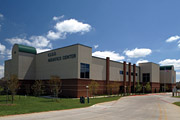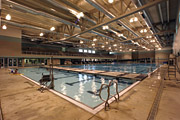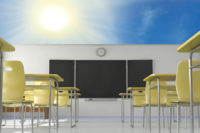
Initially Robert E. (Ed) Cliver, P.E., principal of Estes McClure Associates Inc. (EMA), had designed a generic field-system that combined an air handler using coils coated with an anti-corrosion enamel, a remote condensing unit, and a reheat system that would use compressor heat to warm much of the pool water to 82°F. EMA, a Tyler, TX-based mechanical, electrical, plumbing, and technology (MEPT) engineering firm with hundreds of general school HVAC systems completed throughout Texas, New Mexico, Maryland, Virginia, Oklahoma, and even Mexico, had used a similar dehumidifying strategy in past schools with great success.

The Pinch, Then The Package
The district ran into problems, however, when the project ran over budget during the design phase. The overrun was due mainly to structural costs, but all trades were requested to "think outside the box" in reducing costs. The project's mechanical contractor, H & G Systems (Garland, TX) and manufacturer's representative, McMillan Choate & Associates (Dallas), suggested redesigning the natatorium HVAC system with a Dry-O-Tron™ packaged dehumidifier manufactured by Dectron Internationale (Roswell, GA).Armed with statistical data from other Dallas area indoor pools, Mark McMillan, principal of McMillan Choate, revealed that the natatorium's supply ductwork insulation could be eliminated even though it is a major factor in preventing condensation in the original field-built system design.
Packaged dehumidifiers are designed to maintain a 50% rh and deliver conditioned supply air above the dewpoint, therefore eliminating condensation concerns associated with metal natatorium ductwork. Specifying a packaged dehumidifier with factory-mounted controls, uninsulated duct, and other minor refinements shaved an estimated $35,000 off of the original MEP portion of the project bid and helped bring the project under budget.
"The field-built system would have done the job of dehumidifying just fine; it just wouldn't have done it very economically from the cost perspective," McMillan said. "At the end of the day, they said, ‘For the same money, we can have a simpler system that will work better.'"
Switching to a packaged dehumidifier also saved over 500-sq-ft in mechanical room space because the unit was located outside an exterior wall. The space savings over a field-built system destined for indoors when rated at market rates of $115/sq ft, amounted to an additional $60,000.

Additional Savings
The school district also saved installation costs, according to Kirk Fitzgerald, president of H & G Systems, the Carrollton-Farmers project mechanical contractor. "The simplicity of having a complicated system packaged with onboard controls actually saves cost on the installation, and will continue to save operating costs during the system life," said Fitzgerald. "The control systems applied to field-built systems are sophisticated as well, but I've observed past systems to be operated improperly by maintenance personnel who do not fully understand all aspects of the system. This will cause excessive energy inefficiency, poor control, and premature failure of components." He added that while a packaged system is generally easier to install, it is still complicated. "If someone who doesn't understand the system puts one in, it can cause some serious problems. That said, we've never had a problem with a package system that we've installed.""Even though we've designed a lot of field-built systems in the past, we've established a company design standard now that a packaged dehumidifier will be used with an indoor pool now simply because of the finished product's quality, lower first costs, less space used, and ease of design," said Cliver, who also specified a 15-ton York International Corp. (Norman, OK) rooftop heating/cooling system for offices, the spectator area, and other areas adjacent to the natatorium portion of the building.
The rooftop unit was key to spectator comfort. "When it's 85° in the pool area, the people there watching the events can get hot, so we put cool air in over the area for what is basically constant spot cooling," he said. Using the York unit with a duct system supplied by Spiral of Texas to cool the spectator area provided more savings, Fitzgerald added. Rather than incur additional installation costs by using a packaged unit to provide the sensible heating/cooling, it made sense to use the rooftop unit.

Addition Leads To Innovation
When the Dectron packaged unit was installed at the pool, H & G added two RayPak boilers onto the machine to provide heating - one for the hot tub, and one for the air in the pool. The firm also took all the equipment that had been slated to be installed indoors and put it outdoors, using a glycol system. The modification was so successful that Dectron began providing onboard boiler units with its systems.Only 20 miles away from Carrollton, the 40,000-sq-ft Carroll ISD Aquatic Center (Southlake, TX) was EMA's next major project. Not only did EMA specify a packaged dehumidifier for this project, but the firm deemed it a good candidate to take equipment packaging one step further, adding the manufacturer's onboard 2,200-Mbtuh and 1,750-Mbtuh boilers to the custom-made RS-462 and RS-282 Dectron units serving the 180- by 75-ft pool and 30- by 40-ft warm-up pool, respectively. The onboard boilers condition the pool and the environment in a single package.
Installed by Decker Mechanical (Cedar Hill, TX), the dehumidifier still recovers compressor heat to heat the pool water and space reheat for winter operation. However, the interfaced onboard boiler serves as a back-up pool water heater and space heater, while eliminating the need for a conventional swimming pool heater. According to Cliver, this onboard boiler strategy offers three distinct advantages:
- It frees up precious mechanical room space, especially in this case since the packaged dehumidifier is a rooftop unit;
- It adds a safety dimension by keeping the boiler's natural gas combustion process away from pool chemicals; and
- It uses energy more efficiently.
"We eliminated over 1,000 sq ft of mechanical room space at a significant cost savings, by putting these units and the integral boiler on the roof," said Cliver.
Since the large units had to be custom manufactured to achieve their combined moisture removing capacity of 750 lb/hr of moisture, Cliver also specified other customizations, such as purge fans for quick exhaust during water super-chlorination periods.
The project's success is also attributed to EMA's air distribution design, which consists of a perimeter 48-in.-dia spiral duct system. The 20-ft-high ductwork washes the walls with dehumidified air and is hidden aesthetically in the open architecture ceiling and trusses.
Although the entire building - including the Trane Voyager Series rooftops used for areas other than the natatorium - is controlled by a TAC Americas BAS, Cliver set the unit to control itself with its Dotics 9™ onboard microprocessor controller. The TAC system only monitors the natatorium setpoints.
EMA is now sold on packaged dehumidifiers. "A natatorium is not like a commercial building where you primarily design an air comfort temperature of 72° with air conditioning," Cliver explained. "Instead, a natatorium is designed for 84° air, 82° pool water, and 50% to 60% rh. There are a lot of calculations to be made that culminate with a figure that determines how many pounds of water can be removed per hour," he said. "The packaged units take a lot of the work out of the equation and they save such considerable money. There is still some thinking involved, but you are using proven methods to take a lot of the analysis, out of the equation."
Throughout its 29-year history, EMA has designed hundreds of school HVAC, electrical, plumbing, and high technology contracts and has worked for more than half of the 1,040 school districts in Texas and 47 colleges/universities. However, being selected for school HVAC design work didn't always guarantee the natatorium portion of the project.
Now the firm is sought after for its winning natatorium and sports facility MEPT designs, regardless of whether it's designing the school's general HVAC. With the success of the Carrollton-Farmers Branch ISD and Carroll ISD Aquatic Center, EMA also selected recently completed 10,000-sq-ft Duncanville ISD natatorium in Duncanville, TX, and a 38,000-sq-ft natatorium for Frisco ISD (Frisco, TX). Currently in the planning stage, McKinney ISD (McKinney, TX) natatorium is being designed by EMA.
"The MEPT design we formulated the last few years has made us one of the leading natatorium designers in the state and created a niche that we're very capable and comfortable doing," said Cliver.

Wave Of The Future?
Discovering an approach that works for the consulting firm has been the result of distilling the process to a couple of fundamental tenets that the engineers can stand by. "If you ask me about dehumidifying a pool," said Fitzgerald, "the first thing I'd tell you is, ‘Don't put a pool inside a building.' The second thing I'd tell you is that if you are going to put a pool inside a building, you need to put a packaged unit into the building."ESIn The Other Lane: Fabric duct, dehumidification, other components dive in to enclose former Olympic pool
Providing HVAC for one of the nation's largest natatoriums is a tough task in itself, however engineers and architects for the new Georgia Tech Campus Recreation Center had a tight budget and many pre-existing structural hurdles to negotiate.The 13,300-sq-ft pool, which is the former outdoor pool built for the 1996 Summer Olympics held in Atlanta, serves as the anchor for Georgia Tech's ambitious $45 million, 289,000-sq-ft Campus Recreation Center that surrounds it. The 100,000-sq-ft Aquatic Center that encloses this mammoth competition pool presented a host of HVAC design challenges for Michael Saunders, a senior engineer and business development at design/build mechanical contractor, Lee Company (Franklin, TN), and for Hastings + Chivetta Architects (St. Louis).
The original 1.5-million-gal swimming/diving pools' free-standing, towering 115-ft rain/sun shelter and rooftop photovoltaic cells were to remain as part of a 25-yr research study grant conducted by the university, Georgia Power, and the DOE. The solar system now provides 30% of the building's power. It was Hastings + Chivetta's difficult task to not only design walls and enclose the structure, but also to cost-effectively add 50,000 sq ft of athletic activity spaces in the void between the canopy and pool, space created by removing 13,000 of the 15,000 spectator seats temporarily installed for the Olympics.
Although ingenious, the firm's initial design surpassed Georgia Tech's budget, so many contractors for all trades were required to value engineer the project. The 60-year-old Lee Company subsequently cut the project's HVAC/plumbing budget by several hundred thousand dollars, according to Saunders. The redesign switched out the originally specified double-wall round aluminum metal duct with fabric air dispersion duct from DuctSox (Dubuque, IA), saving over $100,000. In the building's fourth-floor gyms, fabric duct was also threaded through bow trusses and branched out for complete floor coverage.
In the final installation, gray 56-in.-diameter fabric duct distributes dry, conditions air along a wall of exterior windows, and three 36-in.-dia ceiling-hung branches span the entire width of the pool surface. A separate duct run supplies the spectator seating. The duct lengths hanging 50 ft over the pool feature the manufacturer's Sonic Vent technology at three custom-manufactured positions of 1, 5, and 11 o'clock to evenly distribute air while avoiding deflection against the13-ft-deep ceiling joists they run between. "The trick was to get high enough velocity from the fabric duct, but not so much that unnecessary evaporation is caused at the pool surface level," Saunders said.
The natatorium's HVAC design also taps into the university steam loop instead of using dehumidification equipment options that provide heating and cooling. For example, cooling and dehumidifying the 2,000-seat spectator area is handled with a conventional chilled water AHU, consisting of one model MCC-100 from Trane. The chilled water is supplied by the building's 950-ton York chiller and accompanying Evapco 2,850-gpm cooling tower.
For the larger dehumidification loads of the pool, windows, and diving areas, Saunders used three Desert Aire dehumidifiers with a combined capacity of 1,000 lb/hr of moisture removal. The two SA-60s and one ND-60 each provide 26,000 cfm of dehumidified air for the windows, pool, and diving areas, while a 50,000-cfm unit serves the spectator area in the dehumidification process. Nearly 20% of outdoor air makes up the total cfm as calculated by the natatorium standard of .15 cfm/sq-ft.
To eliminate chloromine-laden air that tends to linger above pool surfaces - a long-standing swimmer complaint at many competition pools - Saunders specified seven 3,500-cfm and two 16,000-cfm deck level Loren Cook Co. exhaust fans.
To prevent air stratification where ductwork doesn't occupy the voids between the 56-ft cast-concrete joists, Saunders specified eight 22,000-cfm cross ventilation fans (controlled by variable speed drives in the event a televised swimming meet requires quieter ambient conditions).
While heating is rarely needed in Atlanta's warm climate, the natatorium can be heated on cold winter days via a 12-million-Btu Taco heat exchanger that converts campus steam to hot water to supply the air handlers. Additional distribution of heating is mixed through the dehumidifiers' systems and accompanying fabric duct, as monitored by the campus-wide Johnson Controls Metasys system.
"Transforming this large pool to a facility it wasn't originally intended for, and staying within budget, was very challenging," said Saunders, who has designed several past natatorium projects.

